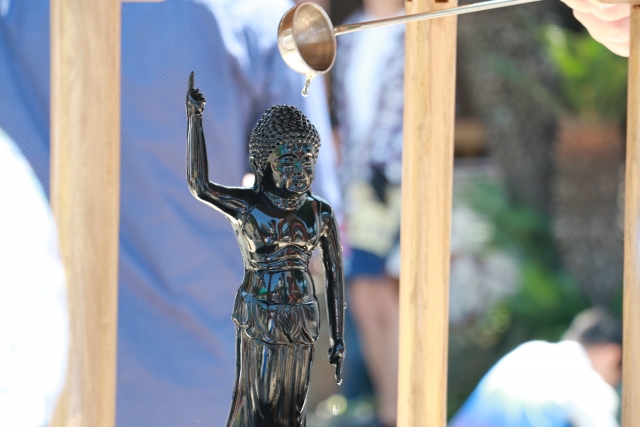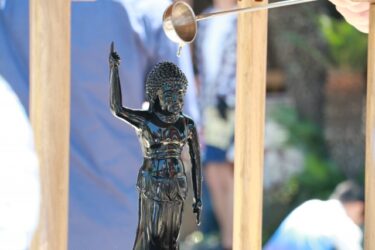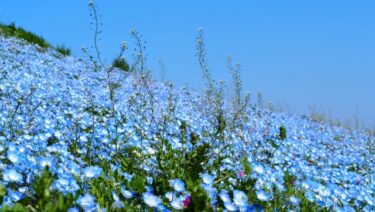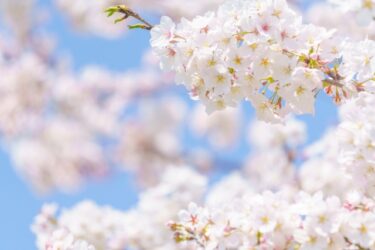The Japanese version is available here.👉https://seohayami1920.com/hanamatsuri-buddha-birthday
In spring, temples across Japan are adorned with colorful flowers, and children can be seen smiling as they pour sweet tea over a small statue.
This heartwarming scene is part of a traditional Buddhist event known as Hanamatsuri, a ceremony rich in meaning and history.
In this article, we’ll explore the origins of Hanamatsuri, its connection to the birth of Buddha, its spiritual significance, and how it remains relevant in our modern lives.
What Is Hanamatsuri? A Buddhist Celebration of Spring
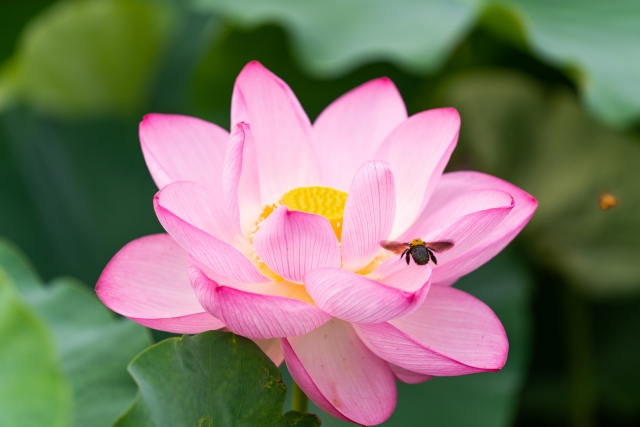
Hanamatsuri, or “Flower Festival,” is a Buddhist event held annually on April 8th to celebrate the birth of the Buddha (Shakyamuni).
The official name of the ceremony is “Kanbutsue” or “Bussyoue”, and it dates back to the Nara period (8th century).
It’s called “Hanamatsuri” because it takes place when cherry blossoms are in full bloom, and the small halls built for the event are beautifully decorated with seasonal flowers.
People of all ages take part in the celebration. Temples offer sweet tea (amacha), and there are often storytelling performances, sermons, and joyful activities for children and families.
Who Was Buddha? A Look at His Birth and Legends
The star of Hanamatsuri is Shakyamuni Buddha, a historical figure born in Lumbini, present-day Nepal, around the 5th century BCE.
His name was Gautama Siddhartha, and he was born a prince of the Shakya clan. However, after witnessing the suffering caused by aging, illness, and death, he left his royal life in search of a way for all people to live in peace and happiness.
1. Blossoms Bloomed Everywhere
The garden of Lumbini burst into vibrant bloom the moment he was born. This legend is the inspiration behind the beautifully decorated “Flower Halls” (Hanamido) used in the ceremony.
2. Sweet Rain Fell from the Sky
Heavenly sweet nectar poured down from the sky to cleanse the newborn Buddha. This is the origin of the ritual of pouring sweet tea over the statue.
3. He Took Seven Steps and Pointed to the Heavens and Earth
Newborn Buddha took seven steps and declared, “Tenjo Tenga Yuiga Dokuson” – “In heaven and on earth, I alone am worthy of respect.”
This phrase symbolizes that each life is precious and unique, not just the Buddha’s.
Rituals of Hanamatsuri: A Celebration of the Senses

The Flower Hall (Hanamido)
The Hanamido is a small, flower-covered hall representing the garden of Lumbini. Inside stands a statue of the infant Buddha, one hand pointing to the sky, the other to the earth.
When I was in kindergarten, I remember pouring sweet tea over the statue and wondering: “Won’t it get sticky? Does someone wash the statue later?”
Even as a child, I was genuinely curious. But when I tasted the sweet tea afterward, its mild flavor made a lasting impression. That was my very first memory of Hanamatsuri.
Pouring Sweet Tea
Visitors pour sweet tea over the statue using a ladle. This symbolizes the sweet rain from the legend and is believed to purify the mind and body, offering prayers for good health and happiness.
People also drink the tea, sharing in the blessings of the Buddha.
Involving Children
Hanamatsuri is a perfect opportunity for children to engage with Buddhist teachings. Wearing little robes, they join the ceremony, pour sweet tea, and listen to monks’ stories. Through these experiences, they naturally learn about gratitude and the preciousness of life.
Hanamatsuri and Japanese Culture: A Deep Connection
Harmony with Spring
Spring is the season of new beginnings and rebirth. Hanamatsuri beautifully aligns with this energy, blending the celebration of Buddha’s birth with the joy of nature’s awakening.
It reflects the Japanese sense of harmony with nature and reverence for life.
Regional Differences
The way Hanamatsuri is celebrated differs by region and temple. Some places have children’s processions, musical performances, or even parades, making it a festive, community-centered event.
The Spiritual Message of Hanamatsuri
Respect for Life

The phrase “Tenjo Tenga Yuiga Dokuson” reminds us that we don’t need to compare ourselves to others. Each of us is a unique and irreplaceable being.
Encouragement to Begin Anew
Held in spring, Hanamatsuri naturally overlaps with life transitions—school entrance, new jobs, moving. It encourages us to take a fresh step forward, with courage and hope.
Hanamatsuri in Modern Japan
Even in a world dominated by smartphones and social media, Hanamatsuri continues to hold meaning.
For children, it’s a rare chance to encounter Buddhist teachings in a fun and friendly setting.
It’s also gaining popularity among international visitors as an introduction to Japanese spiritual culture. The visual beauty of the flowers and the gentle flavor of the sweet tea make it enjoyable for everyone.
Conclusion
Hanamatsuri is a gentle, flower-filled spring tradition that celebrates the birth of Buddha.
It carries messages of respect for life, gratitude, and hope for new beginnings.
I still remember that childhood moment, worried that the sweet tea might make the statue sticky—a small, innocent curiosity that made the day unforgettable.
Through its beautiful rituals and heartfelt messages, Hanamatsuri invites people of all ages to experience peace, connection, and the joy of being alive.
This April 8th, why not visit a temple near you?
Pour sweet tea over the Buddha statue, and let the spirit of spring and the teachings of compassion gently fill your heart.
